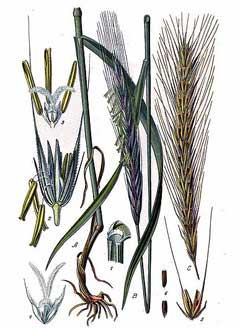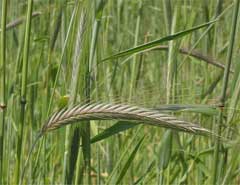 |
|
http://commons.wikimedia.org/wiki/File:389_Secale_cereale_L.jpg |
 |
| http://commons.wikimedia.org/wiki/User:Rasbak |
Translate this page:
Summary
Physical Characteristics

 Secale cereale is a ANNUAL growing to 1.8 m (6ft) by 0.1 m (0ft 4in).
Secale cereale is a ANNUAL growing to 1.8 m (6ft) by 0.1 m (0ft 4in).
See above for USDA hardiness. It is hardy to UK zone 3 and is not frost tender. It is in flower from May to July, and the seeds ripen from August to September. The species is hermaphrodite (has both male and female organs) and is pollinated by Wind.
Suitable for: light (sandy), medium (loamy) and heavy (clay) soils and prefers well-drained soil. Suitable pH: mildly acid, neutral and basic (mildly alkaline) soils. It cannot grow in the shade. It prefers moist soil and can tolerate drought. The plant can tolerates strong winds but not maritime exposure.
UK Hardiness Map
US Hardiness Map
Synonyms
Plant Habitats
Cultivated Beds;
Edible Uses
Edible Parts: Oil Seed
Edible Uses: Coffee Oil Sweetener
Seed - cooked[2, 13, 34, 46]. A common cereal, it is used especially in N. Europe to make bread[183]. The seed contains about 13% protein[61]. The grain also contains some gluten, though not as much as wheat, so it makes a heavier bread than wheat. It can also be used to make cakes etc. The seed can be sprouted and added to salads[183]. A nutritional analysis is available[218]. Malt, a sweet substance produced by germinating the seed, is extracted from the roasted germinated seed and used as a sweetening agent and in making beer etc[13]. The roasted (ungerminated) seed is used as a coffee substitute[46, 183].
References More on Edible Uses
| Composition
|
| Figures in grams (g) or miligrams (mg) per 100g of food.
|
|
|
Seed (Dry weight)
|
|
- 380 Calories per 100g
- Water : 0%
- Protein: 13.2g; Fat: 2.5g; Carbohydrate: 82.5g; Fibre: 2.2g; Ash: 2g;
- Minerals - Calcium: 44mg; Phosphorus: 400mg; Iron: 4mg; Magnesium: 0mg; Sodium: 4mg; Potassium: 524mg; Zinc: 0mg;
- Vitamins - A: 0mg; Thiamine (B1): 0.4mg; Riboflavin (B2): 0.24mg; Niacin: 1.8mg; B6: 0mg; C: 0mg;
- Reference: [ 218]
- Notes: The figures given here are the median of a range given in the report.
|
|
Medicinal Uses
Plants For A Future can not take any responsibility for any adverse effects from the use of plants. Always seek advice from a professional before using a plant medicinally.
Cancer Laxative Poultice
The seed is made into a poultice and applied to tumours[218]. The seed is also an effective laxative due to its fibrous seed coat[269].
References More on Medicinal Uses
The Bookshop: Edible Plant Books
Our Latest books on Perennial Plants For Food Forests and Permaculture Gardens in paperback or digital formats.

Edible Tropical Plants
Food Forest Plants for Hotter Conditions: 250+ Plants For Tropical Food Forests & Permaculture Gardens.
More

Edible Temperate Plants
Plants for Your Food Forest: 500 Plants for Temperate Food Forests & Permaculture Gardens.
More

More Books
PFAF have eight books available in paperback and digital formats. Browse the shop for more information.
Shop Now
Other Uses
Biomass Green manure Oil Soil stabilization Thatching
The straw is used as a fuel or as a biomass in industry[141]. It is quite strong[100] and can also be used in thatching, for paper making, weaving mats and hats etc[13, 34, 46, 61, 171]. Other uses for the straw include as a packing material for nursery stock, bricks and tiles, for bedding, archery targets, and mushroom compost[269]. The plant is a good green manure crop. It is fast growing with an extensive and deep root system[46]. It is especially useful if sown in late autumn. Its growth over the winter will prevent soil erosion and the leaching of nutrients from the soil, it can then be incorporated into the soil in the spring[171]. The extensive root system also makes this a good plant to use for soil stabilization, especially on sandy soils[171].
Special Uses
Food Forest
References More on Other Uses
Cultivation details
An easily grown plant, it succeeds in most soils but prefers a well-drained light soil in a sunny position[1, 132]. It thrives on infertile, submarginal areas and is renouned for its ability to grow on sandy soils[269]. Established plants are drought tolerant[1]. The plant is reported to tolerate an annual precipitation in the range of of 22 to 176cm, an annual temperature in the range of of 4.3 to 21.3°C and a pH of 4.5 to 8.2[269]. Rye is a widely cultivated temperate zone cereal crop. It is able to withstand severe climatic conditions and can be grown much further north and at higher altitudes than wheat[13, 34, 57]. Average yields vary widely from country to country, the world average is around 1.6 tonnes per hectare with yields of almost 7 tonnes per hectare achieved in Norway[269]. There are many named varieties[183]. Rye is a rather variable species and botanists have divided it into a number of sub-species, all of which could be of value in breeding programmes. These sub-species are briefly listed below:- S. cereale afghanicum (Vavilov.)K.Hammer. Native to the Caucasus, western Asia and India. S. cereale ancestrale Zhuk. Native to western Asia. S. cereale dighoricum Vavilov. Native to the Caucasus and eastern europe. S. cereale segetale Zhuk. Native to temperate Asia. Rye grows well with cornflowers and pansies[18, 20], though it inhibits the growth of poppies and couch grass[18, 20]. For polyculture design as well as the above-ground architecture (form - tree, shrub etc. and size shown above) information on the habit and root pattern is also useful and given here if available. The plant growth habit is a clumper with limited spread [1-2]. In garden design, as well as the above-ground architecture of a plant, root structure considerations help in choosing plants that work together for their optimal soil requirements including nutrients and water. The root pattern is fibrous dividing into a large number of fine roots [2-1].
References Carbon Farming Information and Carbon Sequestration Information
Temperature Converter
Type a value in the Celsius field to convert the value to Fahrenheit:
Fahrenheit:
The PFAF Bookshop
Plants For A Future have a number of books available in paperback and digital form. Book titles include Edible Plants, Edible Perennials, Edible Trees,Edible Shrubs, Woodland Gardening, and Temperate Food Forest Plants. Our new book is Food Forest Plants For Hotter Conditions (Tropical and Sub-Tropical).
Shop Now
Plant Propagation
Seed - sow March or October in situ and only just cover the seed. Germination should take place within 2 weeks.
Other Names
If available other names are mentioned here
Native Range
TEMPERATE ASIA: Armenia, Azerbaijan, Ciscaucasia, Iran, Iraq (north), Kazakhstan, Kyrgyzstan, Russian Federation-Ciscaucasia, Tajikistan, Turkey (west), Turkmenistan, Uzbekistan,Afghanistan. TROPICAL ASIA: Pakistan, EUROPE: Russian Federation-European part, European part (south),
Weed Potential
Right plant wrong place. We are currently updating this section.
Please note that a plant may be invasive in one area but may not in your area so it's worth checking.
Conservation Status
IUCN Red List of Threatened Plants Status :

Growth: S = slow M = medium F = fast. Soil: L = light (sandy) M = medium H = heavy (clay). pH: A = acid N = neutral B = basic (alkaline). Shade: F = full shade S = semi-shade N = no shade. Moisture: D = dry M = Moist We = wet Wa = water.
Now available:
Food Forest Plants for Mediterranean Conditions
350+ Perennial Plants For Mediterranean and Drier Food Forests and Permaculture Gardens.
[Paperback and eBook]
This is the third in Plants For A Future's series of plant guides for food forests tailored to
specific climate zones. Following volumes on temperate and tropical ecosystems, this book focuses
on species suited to Mediterranean conditions—regions with hot, dry summers and cool, wet winters,
often facing the added challenge of climate change.
Read More
Expert comment
Author
L.
Botanical References
Links / References
For a list of references used on this page please go here
Readers comment